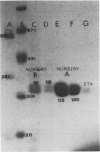Abstract
Clustered epidemics of pustulosis due to Staphylococcus aureus occurred in two geographically distant newborn nurseries. In nurseries A and B an attack rate of pustulosis of 0.8 and 2.0 cases per 100 live births occurred, respectively. Experimental phage type 1046/1116 belonging to phage group II dominated clustered epidemics in nursery A, while group II phage type 3A/3C/55/71 and 3A/3C/55 occurred in nursery B. Other group II strains also occasionally produced clustered epidemics. These epidemic strains were found to be making heat-stable dermal exfoliatin toxin A (ETA) which had a pI of 6.8 and a molecular weight of 32,000 and 33,000. ETA-bearing strains did not make bacteriocin. Children infected with ETA-producing strains developed extensive bullous pustulosis. Surveillance cultures of personnel revealed an ETA-bearing strain in only one person. This strain was not the same phage type as the epidemic cluster. In contrast, ETA-bearing epidemic strains were found in the inanimate environment of both nurseries. ETA protein acts as an important virulence factor in the production of neonatal pustulosis infection and appears to be linked with the ability of S. aureus organisms to stick to the inanimate environment.
Full text
PDF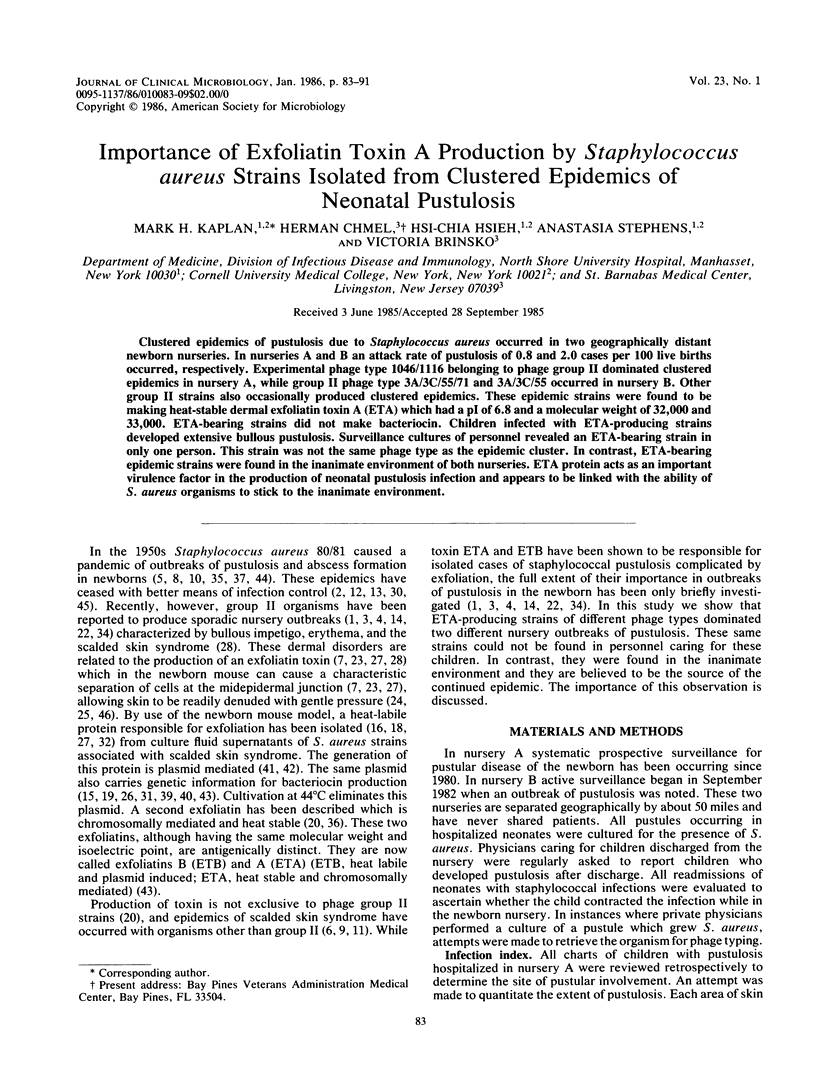
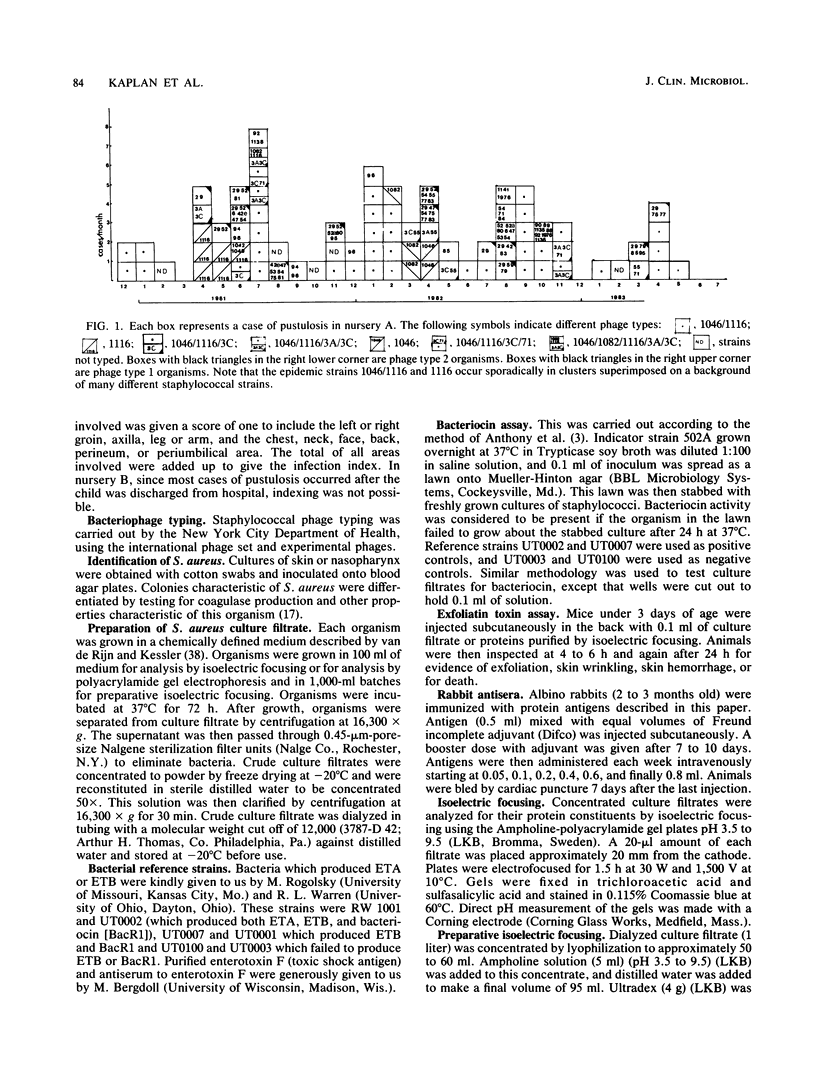
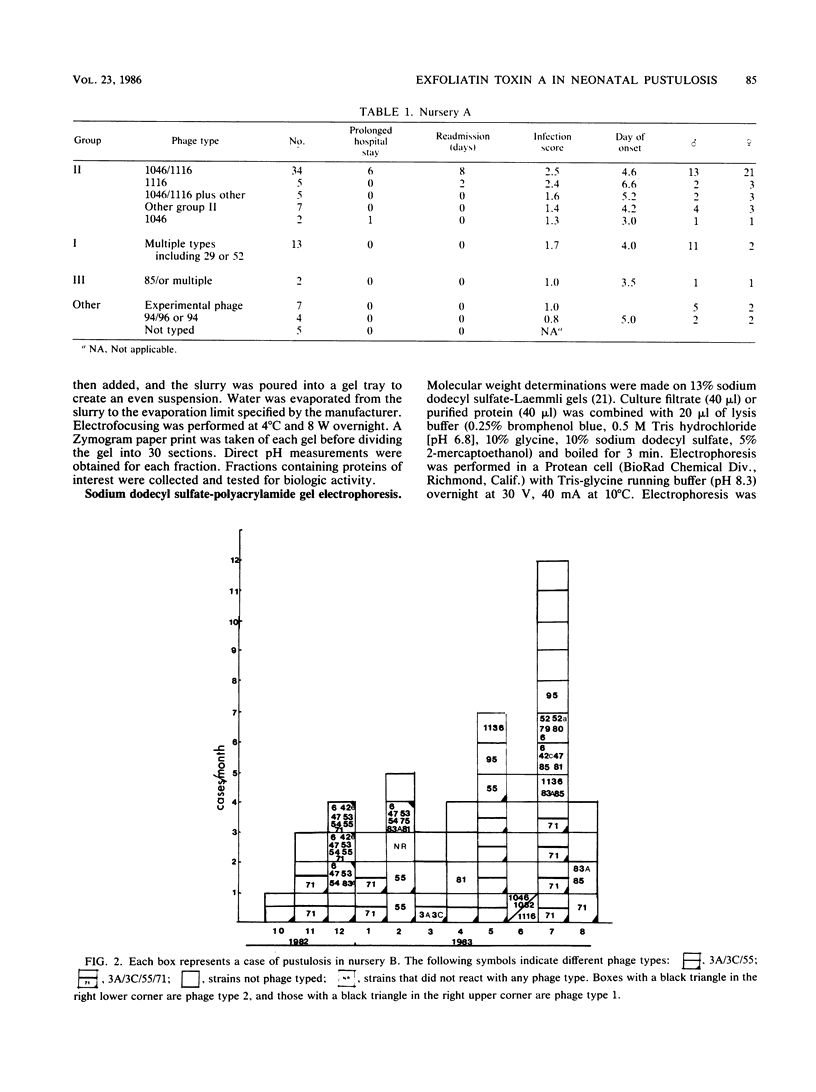
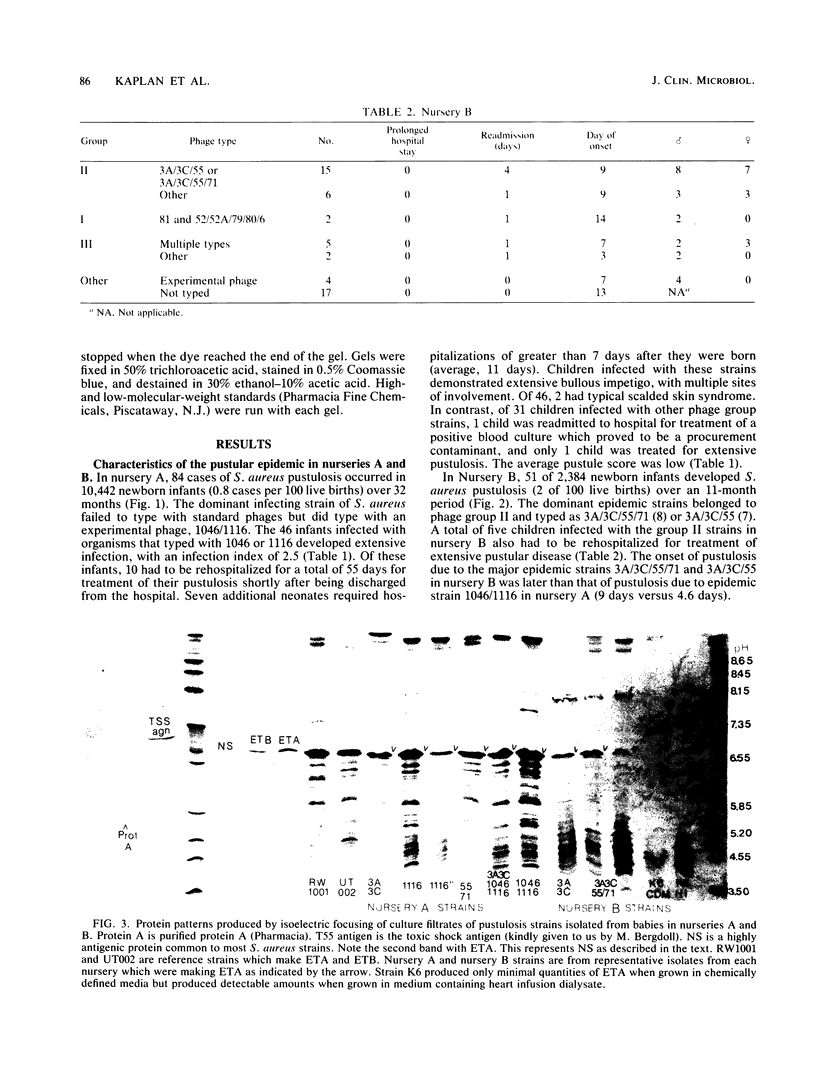
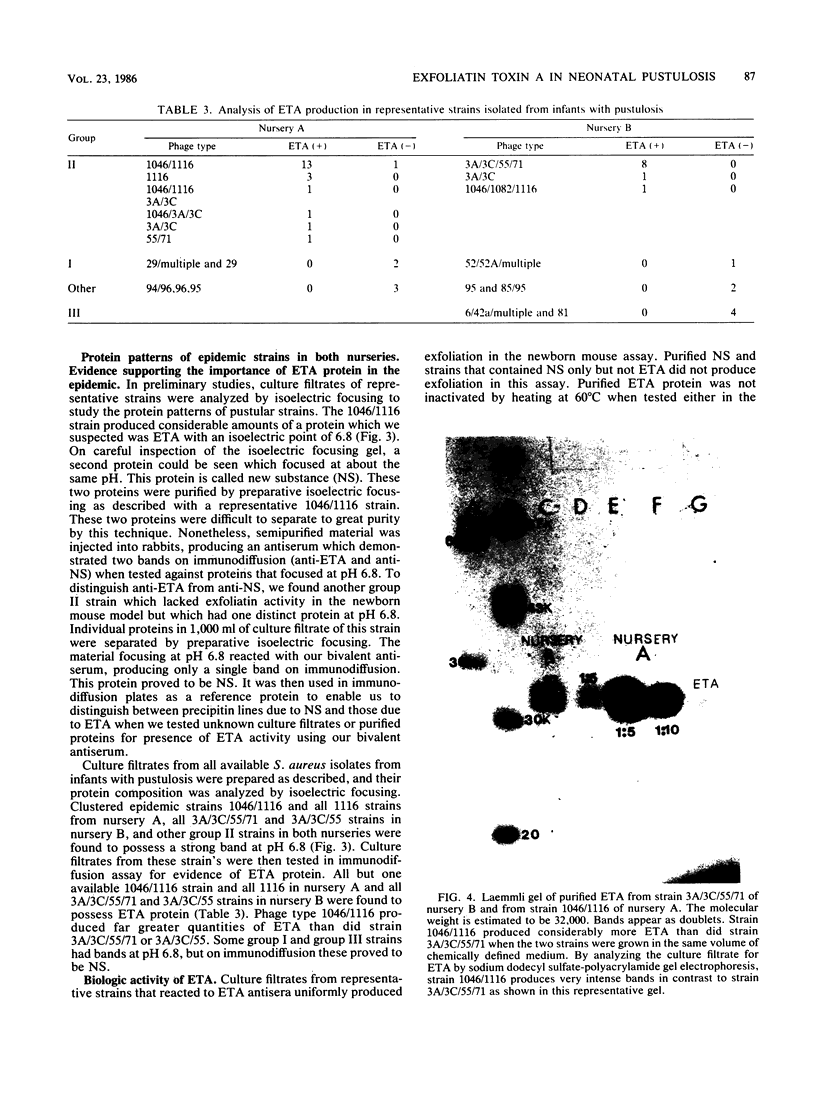
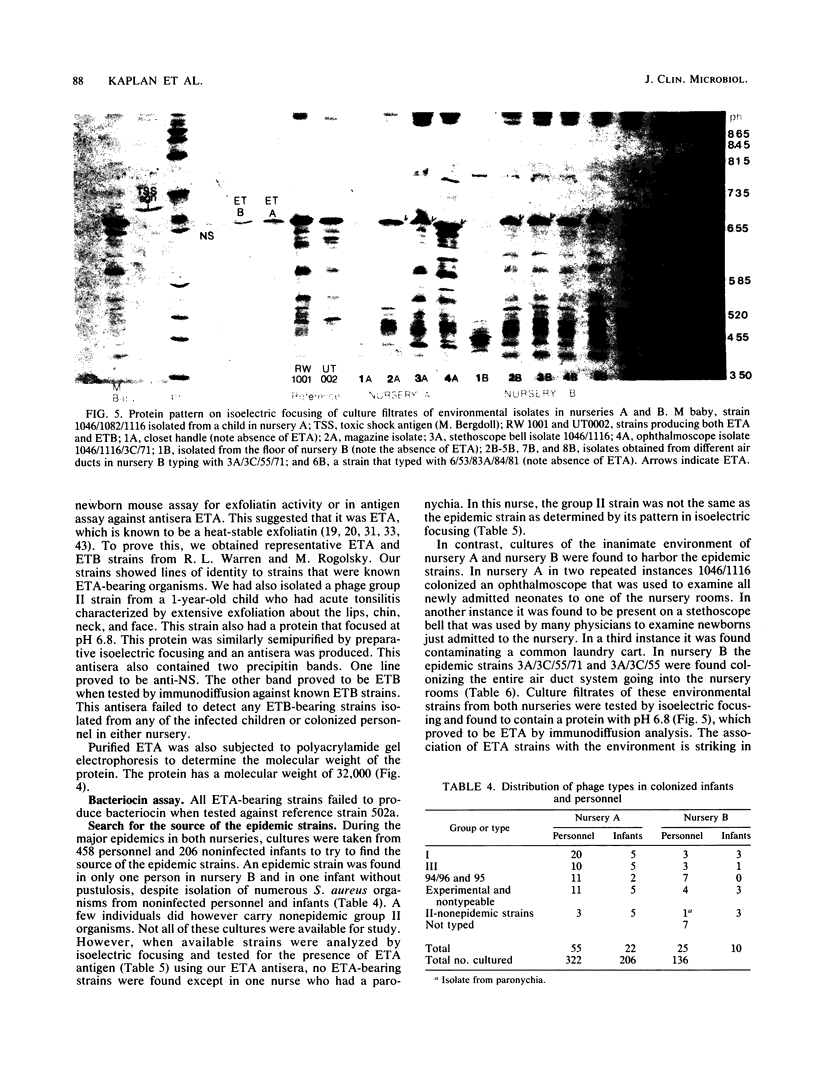
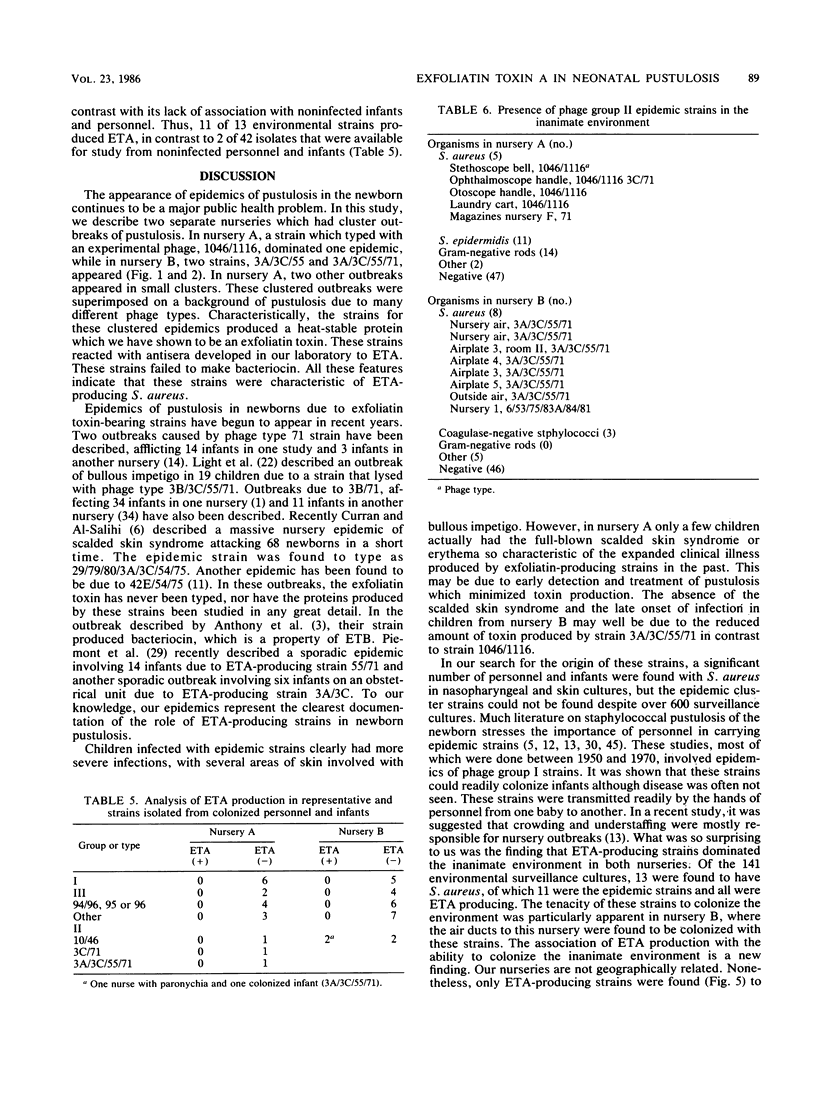
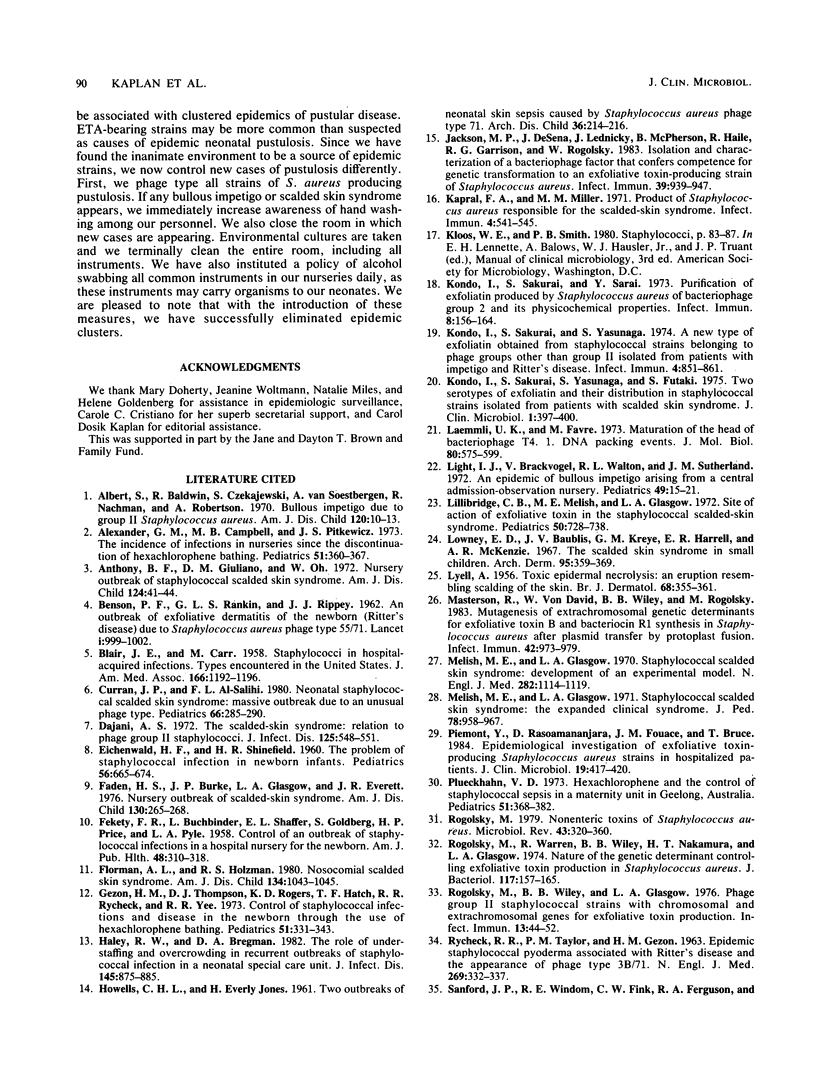
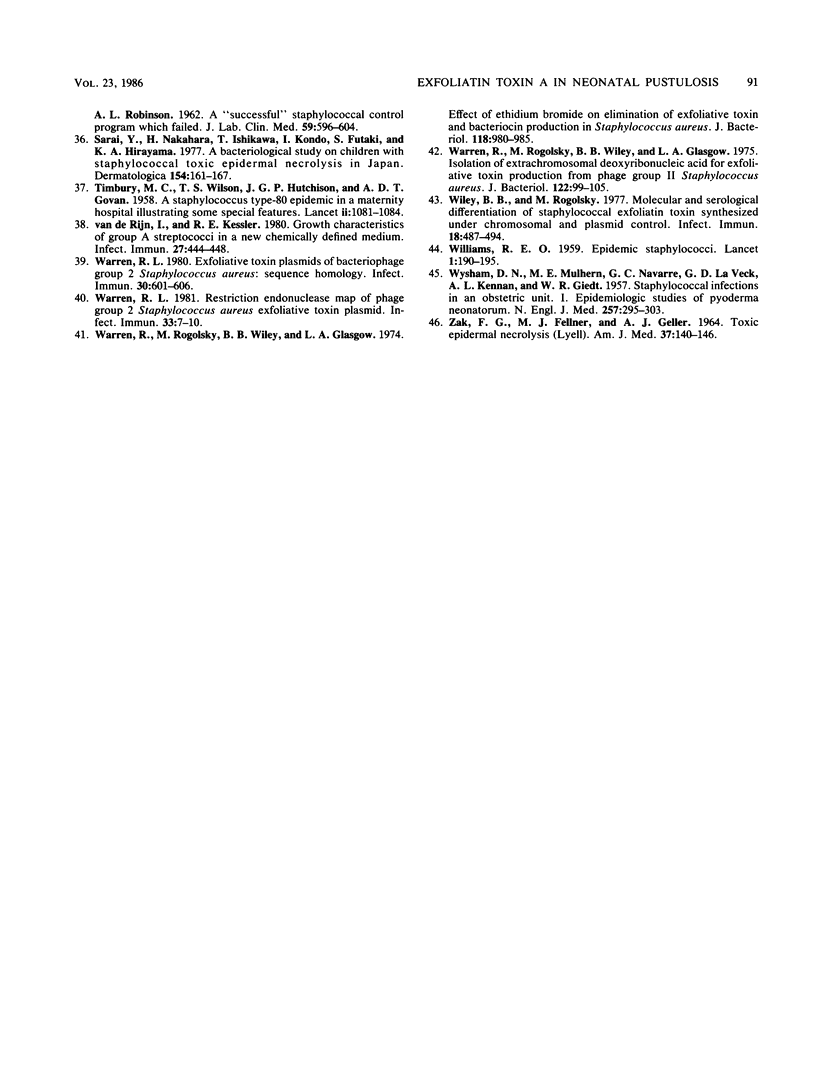
Images in this article
Selected References
These references are in PubMed. This may not be the complete list of references from this article.
- Albert S., Baldwin R., Czekajewski S., Van Soestbergen A., Nachman R., Robertson A. Bullous impetigo due to group II Staphylococcus aureus. An epidemic in a normal newborn nursery. Am J Dis Child. 1970 Jul;120(1):10–13. doi: 10.1001/archpedi.1970.02100060044003. [DOI] [PubMed] [Google Scholar]
- Anthony B. F., Giuliano D. M., Oh W. Nursery outbreak of staphylococcal scalded skin syndrome. Rapid identification of the epidemic bacterial strain. Am J Dis Child. 1972 Jul;124(1):41–44. doi: 10.1001/archpedi.1972.02110130043006. [DOI] [PubMed] [Google Scholar]
- BENSON P. F., RANKIN G. L., RIPPEY J. J. An outbreak of exfoliative dermatitis of the newborn (Ritter's disease) due to Staphylococcus aureus, phage-type 55/71. Lancet. 1962 May 12;1(7237):999–1002. doi: 10.1016/s0140-6736(62)92036-6. [DOI] [PubMed] [Google Scholar]
- BLAIR J. E., CARR M. Staphylococci in hospital-acquired infections; types encountered in the United States. J Am Med Assoc. 1958 Mar 8;166(10):1192–1196. doi: 10.1001/jama.1958.62990100020011d. [DOI] [PubMed] [Google Scholar]
- Campbell A. G., Pitkewicz J. S. The incidence of infections in nurseries since the discontinuation of hexachlorophene bathing. Pediatrics. 1973 Feb;51(2):360–367. [PubMed] [Google Scholar]
- Curran J. P., Al-Salihi F. L. Neonatal staphylococcal scalded skin syndrome: massive outbreak due to an unusual phage type. Pediatrics. 1980 Aug;66(2):285–290. [PubMed] [Google Scholar]
- Dajani A. S. The scalded-skin syndrome: relation to phage-group II staphylococci. J Infect Dis. 1972 May;125(5):548–551. doi: 10.1093/infdis/125.5.548. [DOI] [PubMed] [Google Scholar]
- EICHENWALD H. F., SHINEFIELD H. R. The problem of staphylococcal infection in newborn infants. J Pediatr. 1960 May;56:665–674. doi: 10.1016/s0022-3476(60)80342-3. [DOI] [PubMed] [Google Scholar]
- FEKETY F. R., BUCHBINDER L., SHAFFER E. L., GOLDBERG S., PRICE H. P., PYLE L. A. Control of an outbreak of staphylococcal infections among mothers and infants in a suburban hospital. Am J Public Health Nations Health. 1958 Mar;48(3):298–310. doi: 10.2105/ajph.48.3.298. [DOI] [PMC free article] [PubMed] [Google Scholar]
- Faden H. S., Burke J. P., Glasgow L. A., Everett J. R., 3rd Nursery outbreak of scalded-skin syndrome. Scarlatiniform rash due to phage group I Staphylococcus aureus. Am J Dis Child. 1976 Mar;130(3):265–268. doi: 10.1001/archpedi.1976.02120040043008. [DOI] [PubMed] [Google Scholar]
- Florman A. L., Holzman R. S. Nosocomial scalded skin syndrome. Ritter's disease caused by phage group 3 Staphylococcus aureus. Am J Dis Child. 1980 Nov;134(11):1043–1045. [PubMed] [Google Scholar]
- Gezon H. M., Thompson D. J., Rogers K. D., Hatch T. F., Rycheck R. R., Yee R. B. Control of staphylococcal infections and disease in the newborn through the use of hexachlorophene bathing. Pediatrics. 1973 Feb;51(2):331–344. [PubMed] [Google Scholar]
- HOWELLS C. H., JONES H. E. Two outbreaks of neonatal skin sepsis caused by Staphylococcus aureus, phage type 71. Arch Dis Child. 1961 Apr;36:214–216. doi: 10.1136/adc.36.186.214. [DOI] [PMC free article] [PubMed] [Google Scholar]
- Haley R. W., Bregman D. A. The role of understaffing and overcrowding in recurrent outbreaks of staphylococcal infection in a neonatal special-care unit. J Infect Dis. 1982 Jun;145(6):875–885. doi: 10.1093/infdis/145.6.875. [DOI] [PubMed] [Google Scholar]
- Jackson M. P., DeSena J., Lednicky J., McPherson B., Haile R., Garrison R. G., Rogolsky M. Isolation and characterization of a bacteriophage factor that confers competence for genetic transformation to an exfoliative toxin-producing strain of Staphylococcus aureus. Infect Immun. 1983 Feb;39(2):939–947. doi: 10.1128/iai.39.2.939-947.1983. [DOI] [PMC free article] [PubMed] [Google Scholar]
- Kapral F. A., Miller M. M. Product of Staphylococcus aureus responsible for the scalded-skin syndrome. Infect Immun. 1971 Nov;4(5):541–545. doi: 10.1128/iai.4.5.541-545.1971. [DOI] [PMC free article] [PubMed] [Google Scholar]
- Kondo I., Sakurai S., Sarai Y., Futaki S. Two serotypes of exfoliatin and their distribution in staphylococcal strains isolated from patients with scalded skin syndrome. J Clin Microbiol. 1975 May;1(5):397–400. doi: 10.1128/jcm.1.5.397-400.1975. [DOI] [PMC free article] [PubMed] [Google Scholar]
- Kondo I., Sakurai S., Sarai Y. New type of exfoliatin obtained from staphylococcal strains, belonging to phage groups other than group II, isolated from patients with impetigo and Ritter's disease. Infect Immun. 1974 Oct;10(4):851–861. doi: 10.1128/iai.10.4.851-861.1974. [DOI] [PMC free article] [PubMed] [Google Scholar]
- Kondo I., Sakurai S., Sarai Y. Purification of exfoliatin produced by Staphylococcus aureus of bacteriophage group 2 and its physicochemical properties. Infect Immun. 1973 Aug;8(2):156–164. doi: 10.1128/iai.8.2.156-164.1973. [DOI] [PMC free article] [PubMed] [Google Scholar]
- LYELL A. Toxic epidermal necrolysis: an eruption resembling scalding of the skin. Br J Dermatol. 1956 Nov;68(11):355–361. doi: 10.1111/j.1365-2133.1956.tb12766.x. [DOI] [PubMed] [Google Scholar]
- Laemmli U. K., Favre M. Maturation of the head of bacteriophage T4. I. DNA packaging events. J Mol Biol. 1973 Nov 15;80(4):575–599. doi: 10.1016/0022-2836(73)90198-8. [DOI] [PubMed] [Google Scholar]
- Light I. J., Brackvogel V., Walton R. L., Sutherland J. M. An epidemic of bullous impetigo arising from a central admission-observation nursery. Pediatrics. 1972 Jan;49(1):15–21. [PubMed] [Google Scholar]
- Lillibridge C. B., Melish M. E., Glasgow L. A. Site of action of exfoliative toxin in the staphylococcal scaled-skin syndrome. Pediatrics. 1972 Nov;50(5):728–738. [PubMed] [Google Scholar]
- Lowney E. D., Baublis J. V., Kreye G. M., Harrell E. R., McKenzie A. R. The scalded skin syndrome in small children. Arch Dermatol. 1967 Apr;95(4):359–369. [PubMed] [Google Scholar]
- Masterson R., von David W., Wiley B. B., Rogolsky M. Mutagenesis of extrachromosomal genetic determinants for exfoliative toxin B and bacteriocin R1 synthesis in Staphylococcus aureus after plasmid transfer by protoplast fusion. Infect Immun. 1983 Dec;42(3):973–979. doi: 10.1128/iai.42.3.973-979.1983. [DOI] [PMC free article] [PubMed] [Google Scholar]
- Melish M. E., Glasgow L. A. Staphylococcal scalded skin syndrome: the expanded clinical syndrome. J Pediatr. 1971 Jun;78(6):958–967. doi: 10.1016/s0022-3476(71)80425-0. [DOI] [PubMed] [Google Scholar]
- Melish M. E., Glasgow L. A. The staphylococcal scalded-skin syndrome. N Engl J Med. 1970 May 14;282(20):1114–1119. doi: 10.1056/NEJM197005142822002. [DOI] [PubMed] [Google Scholar]
- Piemont Y., Rasoamananjara D., Fouace J. M., Bruce T. Epidemiological investigation of exfoliative toxin-producing Staphylococcus aureus strains in hospitalized patients. J Clin Microbiol. 1984 Mar;19(3):417–420. doi: 10.1128/jcm.19.3.417-420.1984. [DOI] [PMC free article] [PubMed] [Google Scholar]
- Plueckhahn V. D. Hexachlorophene and the control of staphylococcal sepsis in a maternity unit in Geelong, Australia. Pediatrics. 1973 Feb;51(2):368–382. [PubMed] [Google Scholar]
- RYCHECK R. R., TAYLOR P. M., GEZON H. M. Epidemic staphylococcal pyoderma associated with Ritter's disease and the appearance of phage type 3B/71. N Engl J Med. 1963 Aug 15;269:332–337. doi: 10.1056/NEJM196308152690702. [DOI] [PubMed] [Google Scholar]
- Rogolsky M. Nonenteric toxins of Staphylococcus aureus. Microbiol Rev. 1979 Sep;43(3):320–360. doi: 10.1128/mr.43.3.320-360.1979. [DOI] [PMC free article] [PubMed] [Google Scholar]
- Rogolsky M., Warren R., Wiley B. B., Nakamura H. T., Glasgow L. A. Nature of the genetic determinant controlling exfoliative toxin production in Staphylococcus aureus. J Bacteriol. 1974 Jan;117(1):157–165. doi: 10.1128/jb.117.1.157-165.1974. [DOI] [PMC free article] [PubMed] [Google Scholar]
- Rogolsky M., Wiley B. B., Glasgow L. A. Phage group II staphylococcal strains with chromosomal and extrachromosomal genes for exfoliative toxin production. Infect Immun. 1976 Jan;13(1):44–52. doi: 10.1128/iai.13.1.44-52.1976. [DOI] [PMC free article] [PubMed] [Google Scholar]
- SANFORD J. P., WINDOM R. E., FINK C. W., FERGUSON R. A., ROBINSON A. L. A "successful" staphylococcal control program which failed. J Lab Clin Med. 1962 Apr;59:596–604. [PubMed] [Google Scholar]
- Sarai Y., Nakahara H., Ishikawa T., Kondo I., Futaki S. A bacteriological study on children with staphylococcal toxic epidermal necrolysis in Japan. Dermatologica. 1977;154(3):161–167. doi: 10.1159/000251125. [DOI] [PubMed] [Google Scholar]
- TIMBURY M. C., WILSON T. S., HUTCHISON J. G., GOVAN A. D. A staphylococcus type-80 epidemic in a maternity hospital illustrating some special features. Lancet. 1958 Nov 22;2(7056):1081–1084. doi: 10.1016/s0140-6736(58)92463-2. [DOI] [PubMed] [Google Scholar]
- WILLIAMS R. E. Epidemic staphylococci. Lancet. 1959 Jan 24;1(7065):190–195. doi: 10.1016/s0140-6736(59)90383-6. [DOI] [PubMed] [Google Scholar]
- WYSHAM D. N., MULHERN M. E., NAVARRE G. C., LA VECK G. D., KENNAN A. L., GIEDT W. R. Staphylococcal infections in an obstetric unit. I. Epidemiologic studies of pyoderma neonatorum. N Engl J Med. 1957 Aug 15;257(7):295–303. doi: 10.1056/NEJM195708152570701. [DOI] [PubMed] [Google Scholar]
- Warren R. L. Exfoliative toxin plasmids of bacteriophage group 2 Staphylococcus aureus: sequence homology. Infect Immun. 1980 Nov;30(2):601–606. doi: 10.1128/iai.30.2.601-606.1980. [DOI] [PMC free article] [PubMed] [Google Scholar]
- Warren R. L. Restriction endonuclease map of phage group 2 Staphylococcus aureus exfoliative toxin plasmid. Infect Immun. 1981 Jul;33(1):7–10. doi: 10.1128/iai.33.1.7-10.1981. [DOI] [PMC free article] [PubMed] [Google Scholar]
- Warren R., Rogolsky M., Wiley B. B., Glasgow L. A. Effect of ethidium bromide on elimination of exfoliative toxin and bacteriocin production in Staphylococcus aureus. J Bacteriol. 1974 Jun;118(3):980–985. doi: 10.1128/jb.118.3.980-985.1974. [DOI] [PMC free article] [PubMed] [Google Scholar]
- Warren R., Rogolsky M., Wiley B. B., Glasgow L. A. Isolation of extrachromosomal deoxyribonucleic acid for exfoliative toxin production from phage group II Staphylococcus aureus. J Bacteriol. 1975 Apr;122(1):99–105. doi: 10.1128/jb.122.1.99-105.1975. [DOI] [PMC free article] [PubMed] [Google Scholar]
- Wiley B. B., Rogolsky M. Molecular and serological differentiation of staphylococcal exfoliative toxin synthesized under chromosomal and plasmid control. Infect Immun. 1977 Nov;18(2):487–494. doi: 10.1128/iai.18.2.487-494.1977. [DOI] [PMC free article] [PubMed] [Google Scholar]
- ZAK F. G., FELLNER M. J., GELLER A. J. TOXIC EPIDERMAL NECROLYSIS (LYELL). THE SCALDED SKIN SYNDROME. Am J Med. 1964 Jul;37:140–146. doi: 10.1016/0002-9343(64)90218-9. [DOI] [PubMed] [Google Scholar]
- van de Rijn I., Kessler R. E. Growth characteristics of group A streptococci in a new chemically defined medium. Infect Immun. 1980 Feb;27(2):444–448. doi: 10.1128/iai.27.2.444-448.1980. [DOI] [PMC free article] [PubMed] [Google Scholar]




